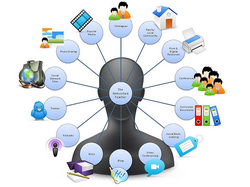One thing I think is often missing in the conversation about tools such as Google Apps is how to actually use them in day-to-day teaching. Knowing what a tool can do in the abstract is far different than seeing the actual concrete example of how it fits into the classroom curriculum.
 Here is a quick snapshot of examples of applying Google Apps in a real classroom:
Here is a quick snapshot of examples of applying Google Apps in a real classroom:Docs:
- Lab notebook shared by lab team
- Collected poems, stories, recipes, or drawings
- Reflection or creative writing journal, shared with teacher
- Peer critique, revision, or editing of written work
- Collaborative planning (with projector)
- Students write practice questions, problems for each other
- Make links of materials used in class to post online (students who are absent, need another copy)
Spreadsheets:
- Collect data during research or labs from multiple people
- Organize topics, jobs, or differentiated tasks
- Create rubrics
- Collect sources from internet research
- Organize what students have checked out
- Dividing tasks for a project or for the classroom
Presentations:
- Make PowerPoints mobile by turning them into a web link
- Make a collection of videos relevant in class, with additional information
- Make a slideshow of pictures and post on a site
- Embed slides on site so students can quickly review information
- Replace poster projects with a slideshow
- Use in concert with a voice-over to produce video instructions
- Replace written book reviews with pictures-only presentations to accompany a talk
- Assign each student a portion of the whole, and have them all make slide(s) on same presentation, then assign for students to use for review or further discussion
Forms:
- Collect information from students easily and quickly
- Project peer evaluations
- Quick formative assessments
- Interest surveys
- Collection of data, sources, or other info you collect over and over
- Parent info
- Voting for student council, class leaders, etc
- Checking in or out materials, books, etc.
- Bathroom/locker check in/out
- Book reviews that can be shared with other kids (like Amazon customer reviews)
Calendar:
- Share classroom calendar with parents and students
- Share calendars with others in your team, group, or department
- Assignment calendar for students
- Embed on site for others to see
- Students can create one to build timelines for history
- Digital datebook
Sites:
- Share daily or weekly information with students or parents
- Flipped classroom videos
- Have students use to show learning on a subject (groups or individual)
- Centralize information for your department, team, or group
- Collect digital materials for class
- Have students create a portfolio to showcase their learning
Drive in general:
Make a digital version of anything and post online for students who have missed class or need review. Especially helpful when large groups of students are gone for activities. Interconnect almost anything you create with anything else. Connect docs with calendar, embed slideshows in docs, add spreadsheets in presentations, add a form to a doc or email. Limitless. And that is just the beginning. Add more tools to build a web of easy, engaging, relevant work with students.

Any of these can be learned in a short amount of time. Please let Tony know if you have a project or lesson that would benefit from the implementation of any of these and he can assist.

No comments:
Post a Comment